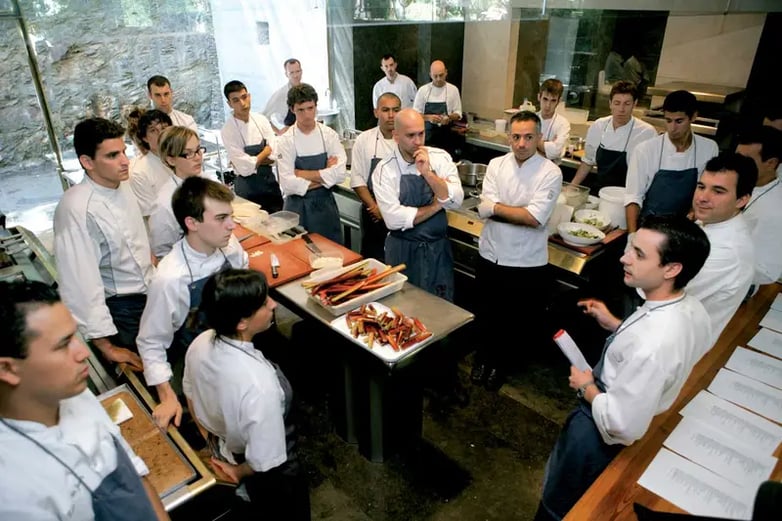Are you an executive chef or restaurant owner wondering about the differences between the front and back of the house?
The front of the house (FOH) includes everything diners experience, from the moment they walk in the door to the service they receive at the table. The back of the house (BOH) is where the kitchen operations happen, ensuring food quality and efficiency.
A well-run restaurant requires a balance between the FOH and BOH, with proper planning, training, and evaluation. By focusing on both areas, you can create a seamless dining experience that keeps customers coming back and employees loyal.
Read on to find out more about how to manage both effectively.
The front of the house is the face of your restaurant. It's where your customers first form an impression of your business.
FOH meaning
What is "Front of House"?
The "Front of House", often abbreviated FOH, refers to everything your customers can see when they dine at your restaurant.
This includes the hostess booth, the dining room, and all the employees and equipment required to keep this portion of your restaurant running efficiently.
Key FOH locations and tips for maintaining them:
Entryway
The entryway sets the stage for the entire dining experience.
Tip: Ensure it is clean, well-lit, and reflects the restaurant’s overall ambiance. Keep the outdoor area tidy and welcoming.
Waiting Area
Provide comfortable seating and ample space for guests to wait during peak times.
Tip: Offer menus to help them pass the time and make informed decisions before they are seated.
Hostess Station
Position the hostess station in a visible and easily accessible location.
Tip: Ensure a host or hostess is always present to greet and seat guests promptly.
Restrooms
Maintain clean and well-stocked restrooms.
Tip: Conduct regular checks throughout the day to replenish supplies and address any issues promptly.
Bar
If you have a bar, keep it stocked with a variety of beverages and staffed by experienced bartenders.
Tip: Maintain a clean and inviting atmosphere.
Dining Room
Dining rooms are the heart of the FOH experience.
Tip: Ensure it is comfortable, well-lit, and has ample space between tables. Keep tables set and chairs clean and inviting.
Outdoor Seating
If you offer outdoor seating, ensure it is clean, protected from the elements, and adorned with comfortable furniture.
Tip: Provide umbrellas for shade and patio heaters for warmth.
Common FOH positions include:
-
Servers: Servers take orders from guests, serve food and drinks, and handle payments.
-
Hosts: Hosts greet guests, seat them at tables, and handle reservations.
-
Bartenders: Bartenders prepare and serve alcoholic and non-alcoholic beverages.
-
Busser: Bussers clear tables, reset them for new guests, and help with other tasks as needed.
- Sommelier: A wine expert who helps guests choose wines that pair well with their meals.
- Barista: A staff member specialized in making coffee and espresso drinks.
- Maitre d’: The head of the dining room staff, responsible for ensuring service quality.
- Section: A designated area of tables assigned to a specific server.
Cross-training FOH employees with BOH roles during onboarding can enhance teamwork and mutual respect, fostering a collaborative work environment.
What is "Back of House"?
The “Back of House” (BOH) in a back-of-house restaurant refers to whatever your customers can’t see when visiting your restaurant.
For most restaurants, this includes the kitchen, walk-in freezers, offices, storage, and anything or anybody else that your customers don’t see.
Key BOH locations and tips for maintaining them:
Kitchen
The kitchen is the heart of the BOH operation and one of the crucial behind-the-scenes areas in a restaurant.
It should be well-organized, well-equipped, and well-maintained to ensure the efficient and safe preparation of food.
Tip: Train staff on food safety and sanitation procedures to prevent foodborne illnesses.
Employee Area
Provide designated break rooms and employee bathrooms to maintain a clean and organized workspace.
Tip: These areas should be stocked with necessary supplies and maintained to a high standard of cleanliness.
Office
Managers should have a dedicated office space to conduct administrative tasks and manage operations away from the hustle and bustle of the kitchen or dining room.
Tip: This space should be organized and equipped with the necessary tools and technology to support their work.
Common BOH positions include:
-
Chefs: Chefs prepare food according to recipes and menus.
-
Cooks: Cooks assist chefs in preparing food.
-
Dishwashers: Dishwashers wash dishes, pots, pans, and other kitchen equipment.
-
Prep cooks: Prep cooks prepare ingredients for chefs and cooks.
-
Stockers: Stockers order and receive food and supplies.
-
Sous chef: The sous chef is the executive chef's second in command, supervising kitchen staff, managing schedules, and playing a crucial role in food preparation. They assist in menu development and training new hires.
- Pastry chef: A chef who specializes in making desserts and baked goods.
How are back-of-house and front-of-house connected?
For any restaurant to run properly, the FOH and BOH staff need to have proper channels of communication in place.
A chef is not expected to walk out into the dining room to take each order from seated guests, just as waiters and food runners are not expected to prepare dishes for a busy restaurant.
For each of these employees to do their jobs they need the front-of-house and back-of-the-house locations to be linked.
A few tools that help achieve this at restaurants are:
-
Table management system
-
POS system
-
Accounting software
-
Inventory management
-
PMS integration software (if you run a restaurant within a hotel)
With these definitions in mind, let’s now see how you can improve operations in both your front of house and back of the house with a few simple changes.
How to improve the front-of-house?
Your front of house is everything that your guests see when they visit your business, and ensuring a positive dining experience makes it the best possible experience for them.
%20(1)-3.webp?width=800&height=450&name=Eat%20(28)%20(1)-3.webp)
Welcoming your guests
Let’s start where your diners do – at the door. The welcome potential guests’ experience can mean the difference between stepping in and taking a table or turning around and heading to your competitor.
It’s crucial to remember that the manner your host or hostesses use when addressing and greeting customers helps to set the tone for their whole dining experience.
A customer doesn’t care if someone has called in sick and you’re understaffed or if your 7 pm table of six has just turned up and is now a table of nine.
When they walk through that door, a customer deserves your undivided attention, a warm greeting, and clear guidance on what to expect.
The very best welcomes involve good eye contact, adapting to the mood and tone of the customer, friendly body language, and clear direction on what will happen next.
It’s important that the welcome host knows where to direct people while waiting for a table and what to say if there are no tables available at that time.
Should they offer the diners nibbles and a drink and give them the expected wait time? Perhaps you’re so packed it’d be better to mention your takeaway service?
Far too often the greeting post is abandoned when the front of the house is busy and this can have a detrimental impact on the whole customer experience.
No matter how busy it is, your host should have a clear and informed plan.
If you want to turn up your guest experience a notch, personalization is key, and the only way to enable personalization is by gathering as much guest data as possible.
Restaurants can use automation software to help build a robust database and create targeted segments like regulars, VIPs, etc. by auto-tagging diners based on a set of criteria like the number of visits and spending amount.
If your restaurant is part of a hotel, this personalization can also be enabled through PMS integration software.
Choosing the right PMS integration provider can provide you with additional guest details at a glance such as a stay duration, hotel room, and preferences - allowing your staff to provide an even more customized experience.
Having access to these important guest details at a glimpse will enable your staff to greet diners with a personal touch which in turn will make them feel important and improve their chances of coming back.
The restaurant owner plays a crucial role in overseeing the staff and operational aspects, ensuring that the front of house employees are well-prepared to provide a smooth and welcoming dining experience.
Online reservations
Harnessing the power of the internet can have a big impact on both organization and time-saving in your front of house.
Shifting from predominantly taking your bookings from email and phone to online frees up a huge amount of time for staff who could otherwise be focusing on hospitality.

For example, let’s say the average time it takes a staff member to record a phone reservation is 2 minutes and the restaurant gets on average 20 bookings a night then that’s a whopping 243 hours and 20 min your staff spends on the phone over the course of a year just taking bookings.
Online reservation systems also help the front-of-house stay organized by automatically adding and assigning tables and time slots to guests.
If the restaurant is full then the booking system will automatically inform the guest and save more unnecessary phone calls.
Understanding the specific responsibilities and skill sets associated with various house positions in both front-of-house (FOH) and back-of-house (BOH) operations is important for optimizing efficiency and delivering exceptional customer service.
Wait times
We’ve said it once and we’ll say it again.
No matter how good your food is or how friendly your staff is, if table and food preparation wait times are not managed, your customer’s perception of the dining experience will diminish.
We’ve covered some great tips for waitlist management in the post about how to keep customers on your waitlist happy.
Ultimately, you need to think about how effectively you manage walk-ins and table-turning, how well your hosts and wait staff set wait expectations, and how well-equipped your front-of-house area is when it comes to entertaining waiting customers.
- Do you have a wait or bar area where waiting customers can sit with a drink and menu while they wait?
- How’s the ambiance? Is your restaurant the type of place that would benefit from some live music?
Think also about how you keep track of tables that need to be readied for the next booking.
Eat App's reservation system, for example, highlights tables that need to be turned at a glance.
But whether you have the support of an app or are relying on your front-of-house team to manage service speed, training your wait staff appropriately is key. Additionally, having a dedicated food runner can significantly improve the workflow by ensuring that food is delivered to tables accurately and efficiently, helping to maintain a smooth dining experience.
Assigned roles, briefing, and debriefing
You can have a burgeoning front-of-house team and a full back-of-house team in action and service can still end up in chaos if there’s no effective role assignment, briefing, and debriefing in place.
Some front-of-house managers like to assign different wait staff to set tables and touchpoints, while others may work with sectors or zones.
Whatever your approach, you should be confident that you have someone to welcome and seat guests along with staff for taking orders and running drinks.
Waiting staff or the front-of-house manager should also touch on tables to ensure the needs of each table are managed and the speed of service is in line with bookings.
A pre-shift brief can highlight any obstacles such as short staffing during a particular time or in a certain area, it should reinforce knowledge of any specials, customer, or staff incentives, and help to effectively motivate staff for the service ahead.
A debrief can also prove useful. Consider praising and thanking staff for their efforts and highlighting any problems that need to be ironed out before the next service.
%20(1)-2.webp?width=800&height=450&name=Eat%20(29)%20(1)-2.webp)
Organization
While a restaurant manager who is adept at spinning many plates is worth hanging on to, in modern restaurant management, technology has a very valuable part to play in effective front-of-house service.
The online and real-time booking technology that can be fed into table planning is consistently rated as one of our customer’s favorite features. It helps you to effectively stagger bookings and allows your welcome host to set realistic expectations for walk-ins who can be added to your table plan when they arrive.
Tech can also be used in the briefing, role assignment, and debriefing. Tables can be assigned to wait for staff ahead of service.
And, thanks to customer profiling, those staff can check on any notes attached to customers’ profiles about dining preferences, allergies, or other special requests.
When it comes to managing table-turning and wait times, color-coding means you can see at a glance when a table is coming towards the end of its allotted time slot and may need service speed increased or a check dropped.
And as an extra bonus, data collected throughout service can be used in staff or customer incentives.
A look at your data may lead you to reward the server who clocked up the highest average cover spend or design a marketing offer to incentivize customers to return during a time slot when bookings are becoming fewer.
How to improve back-of-house operation?
Although the back of the house (for example the kitchen manager) is tucked away conveniently behind your kitchen walls, it is the heart of your restaurant.
Problems in your back of house spread out into your front of house and make running your restaurant harder than it needs to be.
Here are a few tips to improve your back of the house.
The food window serves as an important point of communication between the front of house (FOH) and back of house (BOH), where servers and cooks interact. Having an expeditor can streamline communication and manage order flow effectively.
%20(1)-1.webp?width=800&height=450&name=Eat%20(30)%20(1)-1.webp)
Be transparent
Improving your back of the house starts with your employees.
Transparency is key. Help your back-of-house staff understand the front-of-house operations and needs to make their jobs easier.
Typically, back-of-house employees stay in their roles for the duration of their employment. Whether they start as dishwashers, line cooks, or head chefs, they usually advance within their own area. A dishwasher, for example, is unlikely to transition to a hostess role.
This means most of your employees only know one side of the restaurant. By helping them understand both sides, you can improve teamwork and efficiency.

Holding semi-regular meetings with your entire staff to discuss problems each employee is facing and how their jobs could be better is immensely beneficial in creating a transparent work environment where your employees can start to gain perspective.
Reward employees
Front-of-house employees such as waiters/waitresses have a natural reward system in the form of tips.
That helps keep kitchen staff motivated to do a better job because doing a better job means getting higher tips.
Back-of-house employees, on the other hand, don't have a feedback system in the same way that your general manager or front-of-house staff does.
Taking the time to acknowledge and reward employees for doing a good job can go a long way in boosting morale and motivation.
Rewards don't always have to be monetary, sometimes just acknowledgment and praise are enough.
Check-in with your staff
Because the back-of-house employees are hidden out of sight, it is very easy to forget to check in on how they are doing, especially at a busy restaurant or during a busy shift.
Restaurant managers need to take time out of their day to check in on their back-of-house employees to make sure they have everything they need and nothing is interfering with their ability to do their jobs.
Often times you'll realize that problems don't come to light on their own. They come out when you check in on your employees.
Conclusion
Knowing the difference between the front of house and back of house is important in the restaurant business. Both areas are essential for giving customers a great dining experience. Good teamwork and communication between these two areas help restaurants offer top-notch service and food.
















-1.png?width=1812&height=1072&name=TripAdvisor%20%26%20More%20Bookings%20(1)-1.png)
-2.png?width=1812&height=1072&name=Google%20Bookings%20(1)-2.png)


-1.png?width=200&name=TripAdvisor%20%26%20More%20Bookings%20(1)-1.png)
-2.png?width=200&name=Google%20Bookings%20(1)-2.png)
-1.png?width=200&name=Instagram%20Bookings%20(1)-1.png)
-1-png.webp?width=200&name=Facebook%20Integration%20Rectangle%20(1)-1-png.webp)







.webp?width=200&name=download%20(1).webp)
%20(1)-2.webp?width=200&name=Eat%20(34)%20(1)-2.webp)
%20(1)-2.webp?width=200&name=Eat%20(18)%20(1)-2.webp)










.webp?width=314&height=175&name=image2%20(5).webp)


.webp?width=144&height=72&name=Eat%20App%20Logo%20(3).webp)